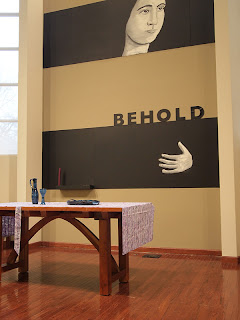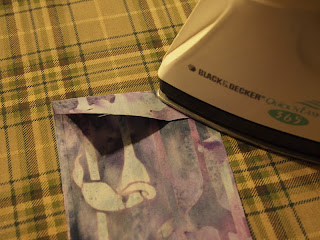Today is the first day of advent. I'm starting to get into it. (It's not quite the Christmas spirit, but it leads into it.)
What helped this year is that I was asked (just last Sunday, I will add) to make an advent cloth for our church. The communion table is generally "dressed" with a liturgical cloth suitable for the current season and we didn't really have an advent cloth.
Although purple has been traditional for advent, blue is becoming more accepted as purple is used for lent. It is also widely accepted to use pink for "Mary's Sunday." I think we found a lovely sort of compromise in this batik fabric which contains lavenders and blues. (The lighter lines of flowers are more blue in person.)
I was also pleased to note that some of the flowers are calla lilies since white lilies are a symbol of Mary. No, I don't go to a Catholic church and I don't venerate Mary, but you can hardly celebrate Christmas (you know, Christmas that still has Christ in it) without realizing that she played a pretty big role in the whole saga.
Anyway, I think the fabric is pretty ideal for the table covering. Plus the batik is so pretty and complex, I didn't need to do anything more than hem the ends and throw it over the table.
But since I can't seem to keep things simple, I decided to make several strips to hang down the front:
There was only one up today because it's only the first Sunday of advent. I'll add one more each week until it will be completed on Christmas. I'm working on a "surprise" to be revealed on Christmas day, but it's not ready yet so I'm not going to tell you about it. (Plus, advent being a time of waiting, it seems appropriate to make you wait to see the whole picture. Sorry if that drives you nuts. ;)
What I can give you today is a little tutorial on the blind hem I used. It's very simple, but it can be tricky to get your head around how it works. But it's well worth the "mind bending" even if it's a little painful because the result is so professional and effective.
First, you fold over the hem to the wrong side at the final depth that you want and press:
Then you fold under the raw edge, trying to make the exposed part of the hem even:
and press it down again: (I love to iron.)
Now you need to do a little flip to get it ready for sewing. It would be hard to describe so I made this short video:
See how simple that is? You don't turn the fabric over (the wrong side still faces you), but just give the hem a little flip, making sure to keep a little bit exposed as shown.
Pin as you go:
Now you'll need to head to the sewing machine. Most machines will have a blind hem option. It's a straight stitch on one side with an occasional zig zag. It looks like this on my machine:
You can see that my machine has the option to do a blind hem to the right or the left. Your machine may only have one option.
You may also have a special foot for your machine, but you don't need to have it. If you do, it will have an uneven bottom--one side will be higher than the other. You put the fabric under the foot so that the ridge of the foot lines up with the fold, as seen here:
As you sew, the seam will be straight along the right side (the upper fold of the hem) and then take an occasional "bite" of the left fold, which is the body of the garment (or tablecloth). You can see in this picture that the machine has just finished taking a bite.
Once it's sewn, you can unfold them hem (and press again). Watching this may help you know what to expect:
Here's the seam as it comes off the machine:
And after unfolding and turning to the right side:
From a little further away, you hardly notice the stitches on the right side.
This is one of the flattest, well hanging hems I know. Try it out!
Some Scrappy Finishes
-
This week, a lot of the quilts we finished looked like they were all made
from scraps.
It was a fantastic week!
Nann sent in this lovely quilt top made...
8 hours ago




















No comments:
Post a Comment
Comments are moderated so you will not see yours post right away. Thank you for leaving a comment; I enjoy reading each one!